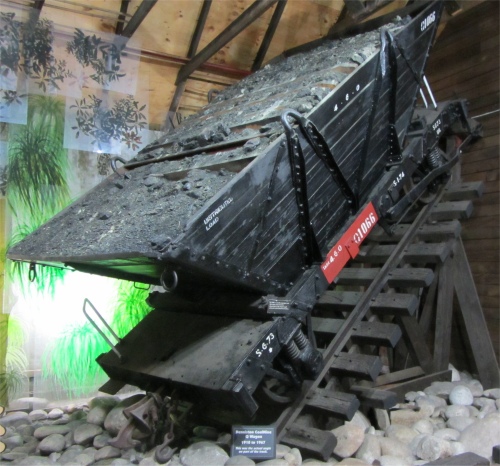 Denniston Incline Exhibit |
The only feature worth visiting in the town was the Coaltown Museum. Coaltown opened in October 1977 after Dominion Breweries donated the building to the people of Westport. Morley & Co. operated a gravitational brewery in this building for nearly 90 years. The purpose of the museum was to help folk imagine life as it was for New Zealand's pioneers. Westport is a town built on coal extracted from wild and remote places like Denniston, Stockton and Millerton, where life was a struggle and comfort a luxury, therefore these towns featured heavily in the museum. A simulated underground coal mine tunnel gave a flavour (and also a smell) of being in a mine. A massive brake-drum from the Denniston incline, together with a coal wagon sitting on a 45 degree incline reflected the workings of the Denniston settlement further north. There was an excellent collection of mining photographs and artefacts.
A small section of the museum was devoted to gold mining, the original lure for people to the coast, and prospectors endured great hardship in search of riches and a better life. Land needed to be cleared and timber milled to create this fledgling community. The museum ran a continuous film on timber milling, and had a collection of the tools used to cut a foothold in the rugged West Coast. Dredges worked the Buller River on which Westport stood, and colliers took the coal away. Today cement ships still use the port. The museum housed a sizeable collection of maritime artefacts and photographs, and also held the massive steam engine from the Bucket Dredge SS Mawhera. Fitting for the building's history, it contained parts of the original brewery and various artefacts from the brewer's trade. Westport's main street once boasted 19 bars and hotels. This was testament to West Coasters "Work hard, play hard" lifestyle.
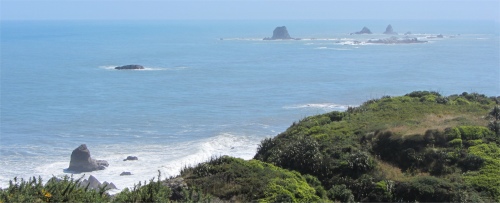 Rocks Off Cape Foulwind |
Having had my culture hit for the day, and desiring an easy going day compared to the punishing schedule I have put myself through recently, I headed out to Cape Foulwind, about 16km west of town.
Abel Tasman made his first New Zealand anchorage off this cape in 1642, a day after sighting land to the south. Tasman, who named the cape Clyppygen Hoeck (Rocky Point) would have seen forested headlands. European settlers cleared the native forests for timber and grazing land, leaving salt-tolerant remnants huddled in gullies and clinging to sheltered, south-facing slopes. Wall Island, off Tauranga Bay, remains in its natural state.
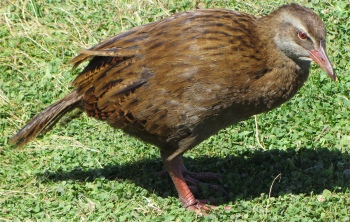 Weka on the Cliffs |
 Horses on Cape Foulwind Walkway |
For Maori living near the mouth of the Kawatiri (Buller River), the cape was an important resting place, and a favoured fish and shellfish area. Omau and Tauranga Bay were popular mussel gathering places. Kekeno were taken for meat, skins and bone.
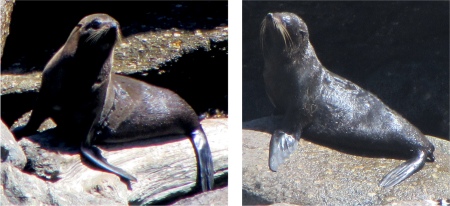 Tauranga Bay Seals |
A level promontory jutting out into the sea had once been a gigantic quarry. Thousands of tons of granite were extracted here from what would have been high cliffs at the time, and transported by rail to Westport where huge blocks were used to create the long breakwaters protecting the mouth of the Buller River. Smaller pieces of gravel were used for road building.
On the northern edge of Tauranga Bay, a seal colony existed. A small group of seals lay dozing away in the sun, flinching when they received a soaking from an exuberant crashing wave.
I dropped down into Tauranga Bay, and treated myself to an ice-cream, and sat at a picnic table to enjoy it. In a short while a couple joined me, who were Danish. Since 1999 they have been spending most winters here, using a week in Sydney to get around the 3 month visa rule that applied to Europeans other than British. They owned a crop farm back in Denmark, which they relied on contractors to run in their absence. They also were partners with some Kiwis in a stock farm midway between Westport and Nelson. I wasn't sure how that worked since he is not allowed to work in the country; perhaps he was a "sleeping partner". The chap's brother also had a farm in Denmark and was partner to one in New Zealand. "Denmark, being part of the European Union, has too many farming subsidies and too much regulation in the farming industry," said the chap. "In New Zealand we are free of that and are part of the global market. Yes we have some lean years here, but also some profitable years." The chap would move out to New Zealand tomorrow, but his wife was still bound to the family back home.
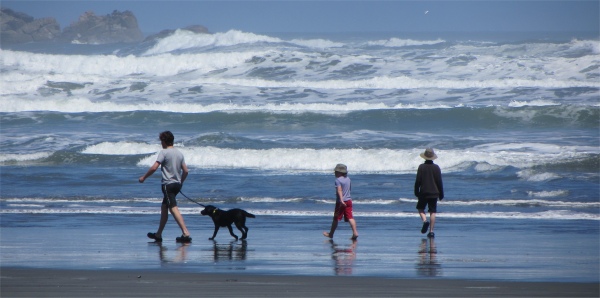 Taking the Dog for a Walk in Tauranga Bay |
I made my way to the North Beach, and ambled along the beach idly watching the surfers. There was a very strong long shore drift taking them up the coast, so periodically they would have to come to shore and walk a long way back down the beach before entering the surf again. It was a blissfully idle day, and I just let myself unwind, normally something which I find hard to do.
When I had enough of the sun's rays and sea air for the day, I headed back to the same campsite, looking forward to a cool beer later.
I met a lady at the site searching for her husband. She was from Christchurch, and lived quite close to the centre. She inspected the centre each week and was saddened to see the skyline slowly disappearing as buildings are pulled down. Aftershocks are still causing damage, and the police station, which had been used since the first quake, has recently been declared unfit, and had to be vacated. She had the true Kiwi spirit of fighting back in the face of adversity, and looked forward to a gleaming new low rise city. "The original estimates to recover were set at $3 billion," she said. "Current estimates now lie in the region of $30 billion. The government fund only comes to $17 billion, so we need a lot of private money from somewhere," she added. She went off to find her husband, leaving me wondering how this country could cope with another large earthquake.
